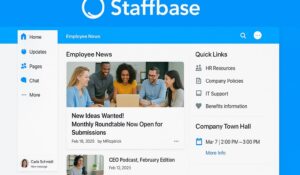Intranet communications have become the foundation of modern workplace connectivity. As organizations embrace hybrid work, global teams, and frontline employees, intranets provide a secure and centralized platform for information, collaboration, and engagement. Unlike scattered emails or chat apps, intranets create a single source of truth for all employees.
A modern intranet software ensures employees receive the right updates, resources, and recognition—wherever they are. Done right, intranet communications boost engagement, streamline workflows, and support organizational growth.
What Is Intranet Communication?
Intranet communication is the practice of sharing information, updates, and resources within an organization through a secure platform. It differs from email or chat-only tools by centralizing news, documents, and feedback loops in one hub.
Unlike the internet, an intranet is private and secure—accessible only to authorized employees. This ensures sensitive data stays within the company. To understand the difference, see intranet vs extranet vs internet.
Benefits of Intranet Communication Tools
Employee intranet communications are the backbone of workplace intranet systems. By centralizing updates, collaboration, and engagement, companies eliminate silos and create a more connected culture.
Key benefits:
- Reduce silos – ensure everyone gets the same updates.
- Centralize updates – replace scattered tools with one hub.
- Boost engagement – two-way feedback, surveys, and recognition.
- Scale with company size – from startups to global enterprises.
Organizations using intranet platforms report a 20–25% increase in productivity, and highly engaged workplaces deliver 23% more profit. Strong cultures—driven by robust internal communications—can grow revenue 4× faster. (Source: Axero)
👉 Learn more about our employee intranet platform and how it powers workplace communications.

Intranet Collaboration & Implementation
Many companies see intranet collaboration as the main reason to adopt a workplace intranet. It enables teams to share knowledge, collaborate in real time, and streamline projects.
Collaboration Intranet Features
- Document sharing and version control.
- Project and task management tools.
- Real-time messaging, forums, and video conferencing.
- Peer-to-peer knowledge bases and wikis.
Together, these features create a true collaboration intranet where employees can work efficiently across teams and geographies. Intranet success hinges on shared ownership—IT ensures stability, while Communications owns content and engagement. Without both teams working together, any tool can fall short as strategic platforms.
Intranet Implementation Best Practices
A successful intranet rollout requires strategy.
- Assess needs – identify workflows and communication gaps.
- Choose the right platform – focus on scalability, integrations, and ease of use.
- Communicate goals – explain why the intranet is being launched.
- Plan rollout campaigns – train employees and build champions.
- Track adoption – monitor engagement through analytics.
Following these best practices ensures smoother intranet implementation and long-term adoption.
Types of Communication Supported by Intranet Platforms
Modern workplace intranet communication tools support multiple types of communication:
Top-Down Communication
Executives can cascade announcements through posts, videos, or alerts. Employees can react, comment, and engage.
Bottom-Up Communication
Surveys, polls, and suggestion boxes enable employee feedback and input.
Peer-to-Peer / Social
Social intranets with features that allow peer recognition, team shoutouts, and casual updates. These tools tie closely to employee engagement activities.
Intranet Communication Channels
A modern intranet unifies multiple channels:
- Newsletters – employee newsletters keep employees informed.
- SOPs & Policies – publish compliance content via SOP intranet tools.
- Mobile push – reach deskless workers (see Employee Apps or our article on Best Intranet Apps).
- Multilingual support – connect global teams with multilingual intranet software.
These features make intranet communications adaptable to every workforce need.
Enhancing Workplace Communications with an Employee Intranet
An intranet workplace transforms how employees communicate and collaborate.
Streamlining Information Sharing
Intranets centralize documents, news, and updates in one location—no more lost email threads.
Facilitating Team Collaboration
Team spaces enable seamless cross-departmental collaboration on projects.
Encouraging Employee Engagement
Discussion forums, directories, and recognition feeds foster a sense of belonging and transparency.
Answering Employees Quickly
A key part of workplace communication is helping employees find answers fast. Instead of wasting time searching through emails or shared drives, a modern intranet with AI-powered intranet search engine surfaces the right information instantly.
Boosting Efficiency with Intranet Features
Workplace intranets improve productivity by:
- Centralized document management – easy access to information.
- Task & project tools – keep everyone aligned with calendars and trackers.
- Automation & integrations – connect HR, payroll, and IT systems seamlessly.
This is why many organizations ask: “Why use intranet?” The answer: efficiency, collaboration, and engagement. Well-designed intranets reduce time spent searching for information by up to 35%, while mobile accessibility boosts frontline engagement by 40%.(Source: LumApps)
Intranet Goals & Trends in 2025
Intranet platforms are now aligned with broader business goals:
- Connection – reach hybrid, remote, and frontline workers.
- Engagement – drive participation through social feeds.
- Efficiency – streamline processes and communication.
- Scalability – expand as the business grows.
Emerging trends:
- Social-style intranets for digital-native employees.
- Mobile-first intranet apps.
- AI-driven content targeting and automation.
- Multilingual support for global teams.
These intranet goals highlight why organizations prioritize workplace intranets in digital transformation strategies.
Examples of Great Intranet Communications
Great intranets inspire through campaigns and practices:
- Digital signage – broadcast intranet updates across offices.
- Recognition campaigns – celebrate employee achievements.
- Global alerts – deliver urgent crisis messages instantly.
👉 For inspiration, explore best intranet websites.
Choosing the Right Intranet Software for Communications
When selecting intranet communication platforms, organizations should evaluate:
- Communication channels supported.
- Analytics and reporting.
- Ease of use for admins and employees.
- Integration with HR and IT systems.
A platform like the HubEngage intranet solution delivers robust employee intranet communications while also supporting intranet collaboration.
👉 Also see our guide on how to choose the right intranet provider.
Conclusion: Transform Your Internal Comms with a Modern Intranet
Intranet communications are now essential to company culture and efficiency. They centralize updates, connect teams, and improve collaboration across all levels of the workforce.
If your company still depends on scattered tools, now is the time to adopt a modern employee intranet platform. It transforms communication from a burden into a driver of engagement and success.
FAQs
What is intranet communication?
Intranet communication is the exchange of information within a private, employee-only network. It includes news, policies, recognition, and feedback tools.
How does intranet improve workplace communication?
It reduces silos, centralizes updates, and enables two-way engagement. Employees can access everything they need in one secure hub.
What are the benefits of intranet communication tools?
They save time, reduce miscommunication, boost employee engagement, and scale with company needs.
What channels are supported by intranet software?
Newsletters, policy hubs, mobile push notifications, social feeds, multilingual updates, and digital signage.
With whom does an intranet communicate?
An intranet communicates with all employees and, if needed, partners or contractors with restricted access.
Why use intranet?
Companies use intranets to improve communication, collaboration, and efficiency while keeping information secure.













